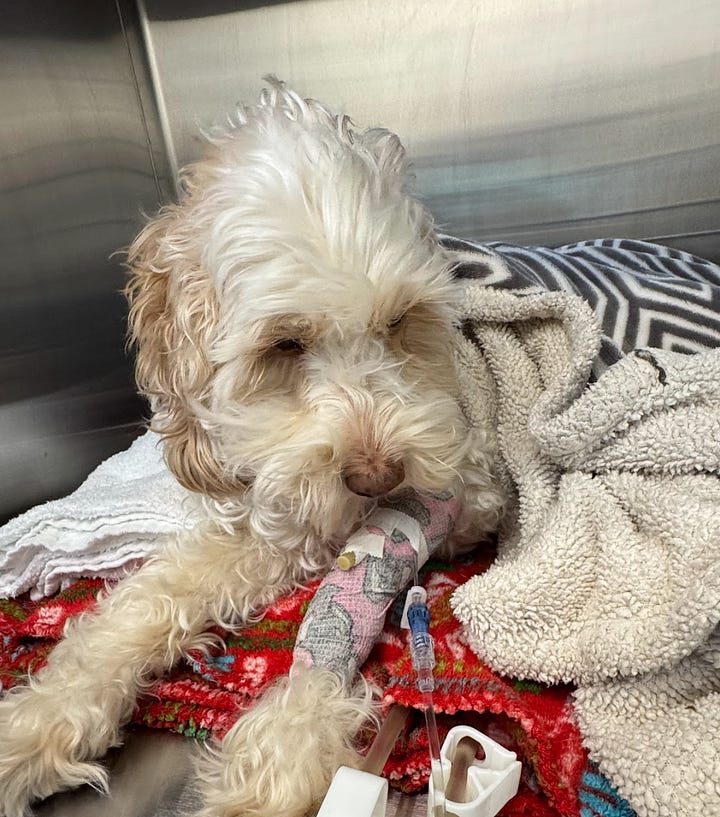The Month of the Spleen: What Four Splenectomies Taught Me About the Weight We Carry
Have you ever had one of those days—the kind that empties you completely? The kind where you walk through your front door, collapse onto the couch, and just stare into space?
That was me after my fourth splenectomy in one month.
Let me explain. A splenectomy is the surgical removal of the spleen. It’s a big surgery, often performed by ER vets or board-certified surgeons. In general practice, we might do one a year—two if it’s an unusual year. But this month, I did four. And each one came with its own weight, its own story, and its own emotional cost.


The first was Buddy, a 4.5-pound Maltese who collapsed at another hospital. They stabilized him, but referred him to me because I’ve done this surgery before. His spleen weighed a third of a pound—nearly 10% of his body weight. The surgery went smoothly, and Buddy recovered like a champ.


Then came Boo, my own dog.
One Monday morning, he collapsed. I knew instantly it was his spleen. He was bleeding internally. I stabilized him, ran tests, and prepped for surgery the next day. Performing splenic surgery on a patient is hard. Performing it on your own dog is something else entirely. Boo’s recovery was physical for him—and emotional for me.


Next came Jake, the beloved cockapoo of one of my longtime employees. He’d been acting “off.” Just… not himself. Lethargic. Staring into space. We took x-rays and were stunned to find a massive, egg-shaped mass where his spleen should be. Our internal medicine specialist confirmed it with an ultrasound. We scheduled surgery. Jake was 12, with other medical issues, so we worried about recovery—but 10 days later, Jake celebrated his 13th birthday, tail wagging and eyes bright.

Then came the fourth one—Remington.
Remington is a 10-year-old German Shepherd with a stoic, sassy personality. He came in for limping. That’s it. Limping on a back leg. I examined him, and he growled when I palpated his back end. Nothing major—just a sore leg, right?
But during sedation for x-rays, my technician Andrea lifted him onto the table and felt something off. Something big.
“Melissa,” she said, “you need to feel this.”
Sure enough—splenic mass #4. X-rays. Ultrasound. Surgery scheduled. And I was already running on empty.
Remington’s surgery was technically the hardest of the four. A cantaloupe-sized tumor. Active bleeding. The omentum (a net-like tissue that acts as the body’s internal bandaid) had stuck itself to the mass to contain the damage. His case pushed every inch of my skill.
And emotionally? It was crushing.
Remington’s owners had just lost their other beautiful shepherd, Jamison, to a tragic and possibly preventable outcome. Now, they were grieving, raw—and I had to deliver this diagnosis. A large splenic mass. It could be benign. It could be hemangiosarcoma, an aggressive cancer with a heartbreaking prognosis. I couldn’t promise them anything. Just that I would do everything I could.
That’s what I carry as a veterinarian. Not just the scalpel or the stethoscope, but the weight of lives, of decisions, of families who hand us their pets and their hope.
Surgery is only one part. Afterward comes the vigil. Splenectomy patients are high-risk. They can throw clots to their lungs or heart. They can bleed. They can develop arrhythmias. The responsibility doesn’t end when I take off the gloves. It lingers.
That night, I had nothing left. Not a drop. My emotional bucket was dry.
We sent all the spleens for pathology. And then we waited.




Here’s the tally:
Buddy – a sarcoma. Cancer.
Boo – hemangiosarcoma. Aggressive cancer.
Jake – benign hematoma. Surgery curative.
Remington – myelolipoma. A rare, benign tumor made of fat and blood cells. Surgery curative.
Buddy and my dog, Boo, lost the cancer lottery.
The others? They’re living their best lives. Jake celebrated a birthday. Remington still has a limp—but no spleen. We’ll get to that leg after he’s fully healed.
So why am I telling you this?
Because this is what it means to be a vet.
Behind every clean white coat is a brain calculating probabilities, a heart breaking or hoping, and hands trying to fix what often feels unfixable. We don’t just treat pets. We carry families. We hold their fear and their love and their desperation, all while doing math in our heads and stitching up what we hope never unravels.
I wouldn’t trade it. But some days, it costs everything I have.
And still—I show up. Because every now and then, you save four lives in one month. And even when one of them is your own, and the outcome isn’t what you wanted, you remember why you chose this path in the first place.
It’s never just a spleen. It’s always a story.





